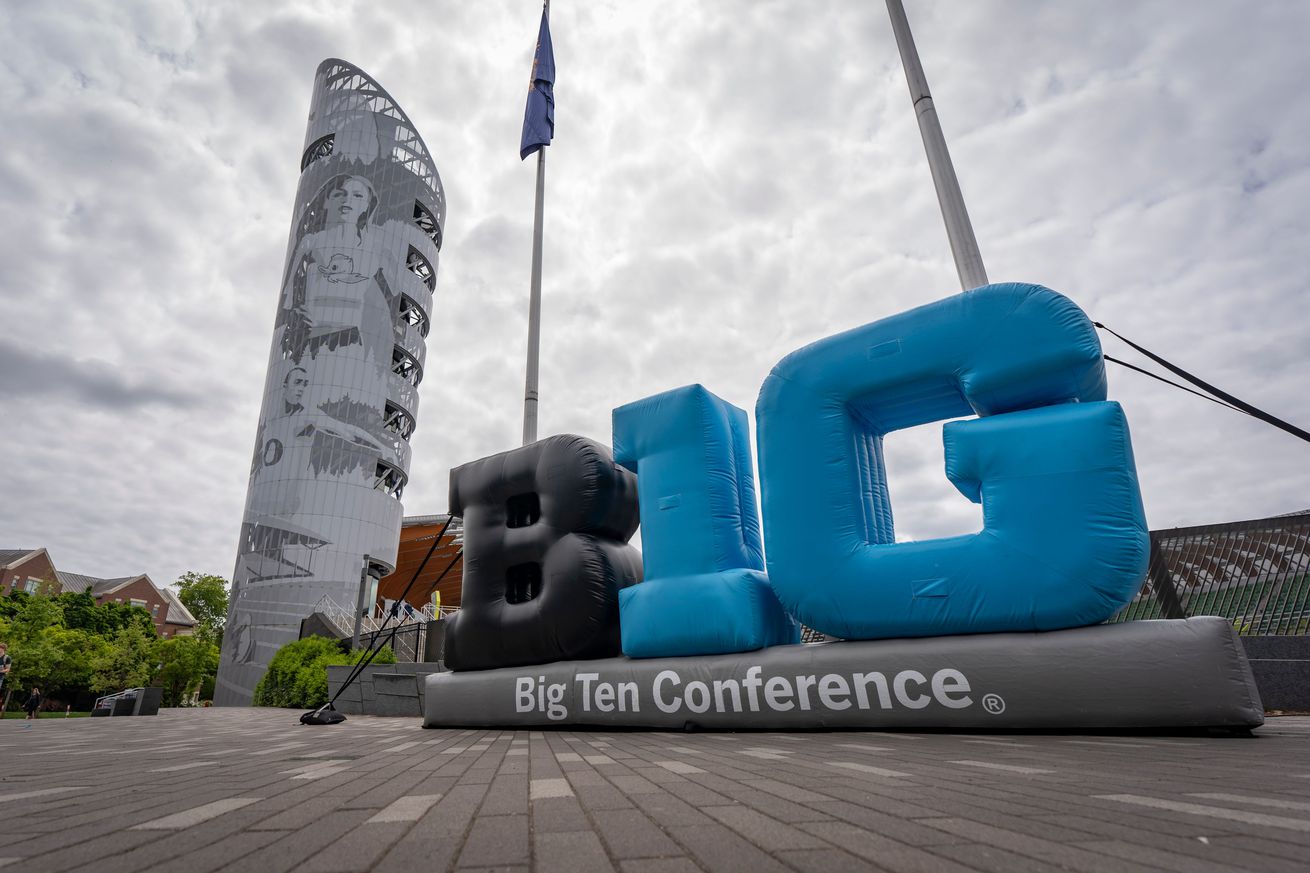
Football and Basketball players will get paid, but will anyone else?
With the June football commitment cycle wound down, we’re basically just biding our time here until we can start football previews. But rest assured, TOC, we’re still going to come up with content for you. Or die trying, to quote Tom Izzo.
Of course, football and basketball lead the way in the Big Ten and throughout college athletics, but today we thought we would take a look at the larger sports landscape in the conference, including how revenue sharing might impact certain sports. Just a quick recap – the House Settlement, which we’ve written about, went into effect on Tuesday. Among other things, this means that, for the first time, schools can share revenue with their student athletes. That share is expected to be up to $20.5 million for the 2025-26 and then go up each year.
Every Big Ten school has committed to paying their athletes the full $20.5 million with the vast majority going to football and basketball players. Some may remain for athletes from other sports, however. We’ll come back to this a bit later but first let’s look at the overall sports landscape in the Big Ten Conference.
One note here – the information that follows all pertains to the 2024-25 academic year, the first year that Oregon, Washington, UCLA, and USC participated in the conference, giving the Big “Ten” 18 actual members.
There are many sports beyond football and basketball that are played at Big Ten schools. NCAA Division 1 programs must offer at least 14 sports (7 for men and 7 for women or 6 for men and 8 women) but all Big Ten schools participate in more than that.
Michigan State competes in 23 sports (11 for men and 12 for women) while Ohio State leads the way by fielding an astounding 37 teams. After OSU, Penn State competes in 31 sports while Michigan sponsors 30. Northwestern has the fewest offerings at 19 while Maryland, Oregon, and Purdue compete in 20.
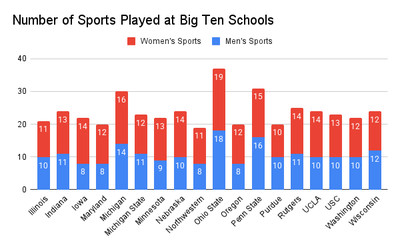
We’re not saying this is Average Joe’s vs. Globo Gym-type stuff but some of these sports are probably less well-known to many of us. For example, Oregon competes in women’s acrobatics and tumbling – the only Big Ten school to do so. The Ducks are also one of five Big Ten universities to compete in women’s beach volleyball along with (predictably) UCLA and USC. Washington and Nebraska also play beach volleyball, the latter of which initially made no sense but then I realized Nebraska has sand dunes and they are, apparently, magnificent .
Among Ohio State’s massive slate of offerings are artistic swimming, men’s and women’s fencing, men’s and women’s rifle, and men’s and women’s pistol – proving, perhaps, that Ohioans like to shoot at their targets with both large and small guns.
This table shows which schools compete in which sports and classifies them according to the number of competing teams:
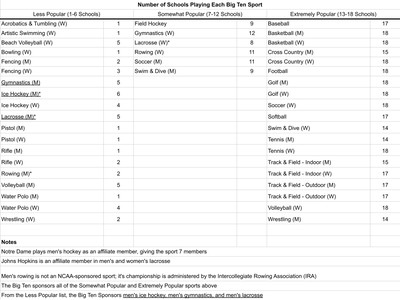
Not all of these sports, however, are sponsored by the Big Ten. This following chart shows all the sports that the conference does sanction and how many of the conference’s 18 teams compete in each one.
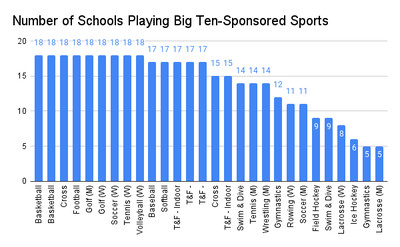
For purposes of this article, a sport was deemed to be sanctioned by the Big Ten conference if it appeared on the conference’s web page and listed team standings and/or conference championship results.
Next, we wanted to look at the “strength sports” for each Big Ten university, at least for the 2024-25 academic year. To reiterate, every Big Ten school is going to prioritize football and basketball. However, some schools may also prioritize their traditionally strong programs.
This may be the case at Michigan State, where Adam Nightingale has revived the hockey program in very short order, winning back-to-back Big Ten championships and turning the Spartans into legitimate national title contenders for the 2025-26 season.
Oregon is very proud of their track and cross country programs, going back at least to the days of Steve Prefontaine and, at Washington, one could probably make a very decent argument that rowing is perhaps second only to football in importance. Many of us have read or seen “The Boys In the Boat” that chronicles the Huskies’ triumph at the 1936 Olympics. Nowadays, unlike Joe Rantz and his crew, who came primarily from the farms and forests of Washington, we’re much more likely to see athletes from all over the world come to Seattle, and many other top American college programs, to race boats. Washington, however, still remains one of the elite programs in the country.
Schools may also choose to prioritize emerging sports, or sports that have recently shown a lot of momentum. Women’s gymnastics at Michigan State may be an example here. The Spartans are surging under the direction of head coach Mike Rowe. Michigan State won the 2024 Big Ten championship before finishing second to UCLA this year and then advancing to the NCAA semi-final meet.
This table shows the top three finishers for each Big Ten-sanctioned sport for 2024-25:
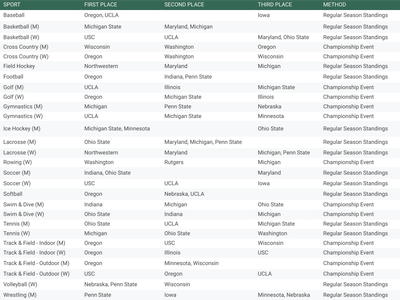
Placement was determined by either regular season standings or a stand-alone conference championship event. If regular season standings were shown on the Big Ten’s website then those were used. If not, results from a conference championship event were used.
This table shows how many top-3 finishes each school earned in 2024-25 and in what sports they were earned:
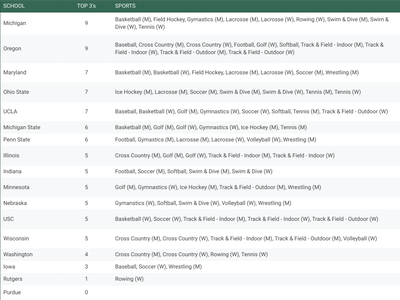
Michigan and Oregon led the way with 9 top-3 finishes each but, in the Wolverines’ case, three of those came in sports with just five or six competing teams (men’s gymnastics and men’s and women’s lacrosse). As indicated earlier, in addition to winning the regular season football and baseball championships in their first year in the league, Oregon was incredibly strong in cross country and track and field events. Also, Oregon secured these top-3’s while fielding just 20 sports while Michigan produced the same amount of top-3’s in 30 sports.
The Spartans were much closer to the top of the pack here than the bottom with 6 top-3’s. In addition to regular-season men’s basketball and hockey championships (and the hockey tournament crown), MSU has strong seasons from their golfers, gymnasts, and men’s tennis players.
One last thing to look at from a competitive standpoint was how schools did across all sports. The following chart attempts to look at that by averaging a school’s placement position across all sports in which they compete. However, instead of just looking at average placement in the regular season standings or championship event, the number of teams a school had to compete against to earn their position was considered.
For example, in this case, Michigan’s State’s men’s basketball championship, which was won against 17 other men’s basketball teams, is worth more than the hockey championship won against 6 other teams. The basketball “placement” is shown as 1/18 (0.056) while hockey is 1/7 (0.143). So, all results are decimals and a lower decimal is better.
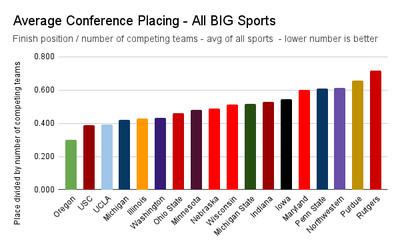
Across all sports, MSU was firmly towards the middle of the pack for the 2024-25 academic year while it’s rather surprising how well the West Coast schools did in their first year in the league.
Now, finally, back to revenue sharing. Many schools are tight-lipped about exactly how they are going to divvy up their $20.5 million. Generally, however, football teams are expected to get about 75% ($15,375,000), with men’s basketball receiving 10-15% ($2,050,00 – $3,750,000), women’s basketball 5-10% ($1,025,000 – $2,050,000), and any remaining amount going to athletes from other sports.
This table summarizes how each Big Ten school might allocate their rev share but note that much of this is not confirmed and comes from sources outside the actual athletic departments.
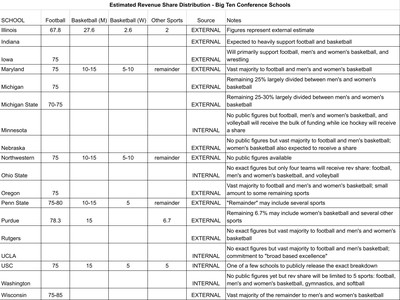
Beyond the general consensus that football and basketball will receive the vast majority of rev share dollars, there are a few schools that have provided some specifics. For example, Minnesota has indicated that volleyball and hockey will receive a share. Ohio State , meanwhile, has indicated that only football, men’s and women’s basketball, and volleyball will receive rev share. Similarly, Washington has indicated that only five sports will receive rev share: football, men’s and women’s basketball, gymnastics, and softball.
For their part, Michigan State is expected to allocate 70-75% for football with the vast majority of the remaining 25-30% going to men’s and women’s basketball. O posted a survey about this a few weeks ago and several readers responded in the comments.
Let’s just say MSU gives 75% to football, 15% to men’s basketball, and 5% to women’s basketball – or some combination that adds up to 95%. This leaves $1,025,000 for all the other sports.
It seems like the Spartans would want to keep hockey moving in the right direction. There were 26 players on the hockey roster last year so, if hockey gets everything that remains, that’s about $39,500 per player. Rival Minnesota has indicated they will share with their hockey players so will MSU need to follow suit?
Or what about gymnastics, where at least one Big Ten competitor (Washington) has indicated they will share revenue? There are 20 gymnasts listed on MSU’s 2025-26 roster so, if gymnastics got everything that was left over, that would be $51,250 per athlete – a little more bang for the buck than hockey but it’s hard to imagine MSU ignoring what has quickly become an elite program again.
Or volleyball, where some Big Ten schools have indicated they will share revenue? If everything went here, an average of nearly $57,000 could go to each of MSU’s 18 volleyball players.
Or, does MSU try to support each of 64 athletes on these three teams at an average of about $16,000 each?
Obviously, the more you spread it out, the less impact it has. Michigan State, like all schools, may need to carefully consider how to allocate their rev share to attract, and keep, top talent in East Lansing.
